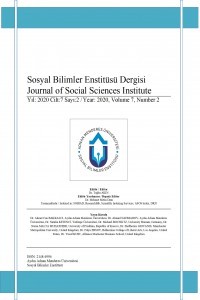YAŞLILIK VE SAĞLIK HARCAMALARI ARASINDAKİ İLİŞKİ: LİTERATÜR TARAMASI
Nüfus Yaşlanması, Sağlık Harcamaları
___
- Bryant, J., (2003) “Modelling the effect of population ageing on government social expenditures”, New Zealand Treasury Working Paper, http://www.treasury.govt.nz/publications/research-policy/wp/2003/03-15/twp03-15.pdf
- Burner, T.S., Waldo, D.R., McKusik, D.R., (1992) “National health expenditures projections through 2030”, Health Care Financing Review. 14, 1-29, https://www.cms.gov/Research-Statistics-Data-and-Systems/Research/HealthCareFinancingReview/Downloads/CMS119123 7dl.pdf
- Cattaneo, M.A., Wolter, S.C., (2009) “Are the elderly a threat to educational expenditures?”, Eur. J. Polit. Econ. 25, 225–236
- Cutler, D.M., Sheiner, L., (1998) “Demographics and medical care spending: standard and non-standard effects”, National Bureau of Economic Research, Paper No. 6866, 1-54, http://www.nber.org/papers/w6866.pdf
- Dang, T., Antolin, P., Oxley, H., (2001) “Fiscal implications of ageing: projections of age-related spending”, Economics Department Working Papers No.305 Paris: Organisation for Economic Co-Operation and Development, http://www.oecd-ilibrary.org/docserver/download/503643006287.pdf?expires=1491914374&id=id&accname=guest&checksum=8CE20C6C1E0C3C0B47BB1F434E531862
- Disney, R., (2007) “Population ageing and the size of welfare state: Is there a puzzle to explain?”, European Journal of Political Economy. 23, 542-553
- Felder, S., Meier, M., Schmitt, H., (2000) “Health care expenditure in the last months of life”, Journal of Health Economics . 19 (2000), 679-695
- Getzen, T.E., (1992), “Population ageing and growth of health expenditures”, Journal of Gerontology; Social Sciences. 47, 97-108
- Gonzalez-Eiras, M., Niepelt, D., (2007) “Population ageing; government budgets, and productivity growth in politico-economic equilibrium”, Study Center Gerzensee, http://www.szgerzensee.ch/fileadmin/Dateien_Anwender/Dokumente/working_papers/wp-0705.pdf
- Gradstein, M., Kaganovich, M., (2003) “Aging Population and Education Finance”, J.Public Econ, 88, 2469-2485
- Gray, A., (2005) “Population ageing and health care expenditure”, Oxford Institute of Ageing, Ageing Horizons. 2, 15-20
- Harris, A.R., Evans, W.N., Schwab, R.M., (2001) “Education spending in an aging America”, J. Public Econ. 81, 449–472.
- Hollanders, D.A., Koster., F., (2013) “Aging and the politics of the welfare state”, Netspar Discussion Paper No. 11/2013-065, http://arno.uvt.nl/show.cgi?fid=132377
- Jager, P., Schmidt, T., (2016) “The Political Economy of Public Investment When Population is Aging: A Panel Cointegration Analysis”, Eur. J. Polit, Econ. 43, 145-158
- Krieger, T., Ruhose, J., (2013) “Honey, I shrunk the kid’s benefits-revisiting intergenerational conflict in OECD countries”, Public Choice 157, 115-143
- Lee, R., Miller, T., (2002) “An Approach to forecasting health expenditures, with application to the U.S. Medicare System”, Heatlh Servies Research. 37(5), 1365-1386, http://onlinelibrary.wiley.com/wol1/doi/10.1111/1475-6773.01112/full
- Lubitz, J., Cai, L., Kramarow, E., Lentzner, H., (2003) “Health, life expectancy, and health care spending among the elderly”, The New England Journal Medicine. 349, 1048-1055
- Poterba, J.M., (1996) “Demographic structure and the political economy of public education”, J. Policy Anal. Manage. 16, 48–66.
- Razin, A., Sadka, E., Swagel, P., (2002) “The aging population and the size of the welfare state”, Nber Working Paper Series, http://www.nber.org/papers/w8405
- Sanz, I., Velazquez, F., (2007) “The Role of Ageing in the Growth of Goverment and Social Welfare Spending in the OECD”, Eur. J. Polit. Econ. 23, 917-931
- Seshamani, M., Gray, A., (2003) “Health care expenditures and ageing: an international comparison”, Applied Health Economics and Health Policy. 2(1), 9-16
- Seshamani, M., Gray, A.M., (2004) “A longitudinal study of the effects of age and time to death on hospital costs”, Journal of Health Economics. 23, 217-235
- Shelton, C.A., (2007) “The ageing population and the size of the welfare state: Is there a puzzle?”, Journal of Public Economics. 92, 647-651
- Simonovits, A., (2004) “A note on the aging populations and the size of the welfare state”, Institue of Economics, Hungarian Academy of Sciences Budapest. http://www.econ.core.hu/doc/simonov/rss.pdf
- Sørensen, R.J., (2013) “Does aging affect preferences for welfare spending? A study of peoples' spending preferences in 22 countries”, 1985–2006. Eur. J. Polit. Econ. 29, 259–271.
- Stearns, S.C., Norton, E., (2004) “Time to include time to death ? The future of health care expenditure projections”, Health Economics. 13, 315-327, http://onlinelibrary.wiley.com/doi/10.1002/hec.831/epdf
- Strunk, B.C., Ginsburg, P.B., (2002) “Aging plays limited role in health care cost trends”, Data Bulletin Center for Studying Health System Change. 23, 1-2, http://www.hschange.org/CONTENT/473/473.pdf
- Tepe, M., Vanhuysse, P., (2009) “Are ageing OECD welfare states on the path to gerontocracy ?”, J. Public Policy 29, 1-28.
- Yang, Z., Norton, E., Stearns, S.C., (2003) “Longevity and healthcare expenditures: The real reasons older people spend more”, Journal of Gerontology. Social Sciences. 58, 2-10, http://citeseerx.ist.psu.edu/viewdoc/download?doi=10.1.1.598.8662&rep=rep1&type=pdf
- Zweifel, P., Felder, S., Meirs, O.G., (1999), “Ageing of population and health expenditure: a red herring”, Health Economics. 8, 485-496
- Zweifel, P., Ferrari, M., (1992), “Is there a Sisyphus Syndrome in Health Care”, Developments in Health Economics and Public Policy. 1, 311-330
- Yayın Aralığı: Yılda 2 Sayı
- Başlangıç: 2014
- Yayıncı: Aydın Adnan Menderes Üniversitesi
Yaşlı Yoksulluğunun Yarattığı Sosyal ve Psikolojik Sorunlar: Muğla Örneği
Mevlüde Türkan, Sergender SEZER
Dünya’da Hayvan Refahı Uygulamalarının Ekonomik ve Sürdürülebilirlik Açısından Değerlendirilmesi
Geçiş Ekonomilerinde Gelir Eşitsizliği ve Ekonomik Sistem İlişkisi
Hatice KÜÇÜKKAYA, E. Yasemin BOZDAĞLIOĞLU
Türkiye Kamu Yönetiminde Yönetişim Algisi: Aydin İli Vergi Dairelerinde Bir Uygulama
YAŞLILIK VE SAĞLIK HARCAMALARI ARASINDAKİ İLİŞKİ: LİTERATÜR TARAMASI
Türkiye’de Mali Teşvik Sistemi ve Yatırımlara Sağlanan Mali Teşviklerin Değerlendirilmesi
E-Wom’un Tüketicilerin Tatil Satın Alma Niyetine Etkisi
Fatma Çakır, Nurhan Aybar, Gökhan Akel
Mevsimsel Değişkenliklerin Borsa İstanbul Üzerindeki Oynaklık Etkisi: Ramazan Ayı Örneği
Alper Yılmaz, Zeliha Can Ergün
Sosyal Güvenlik Kurumları Açısından İllerin Analizi: MOORA Yöntemi
